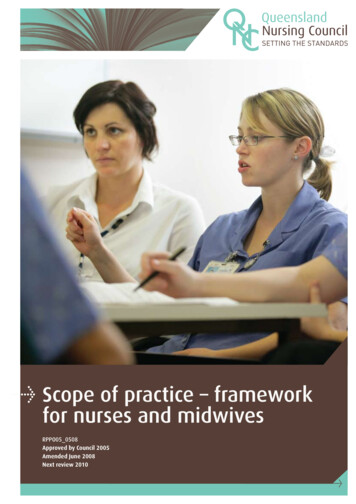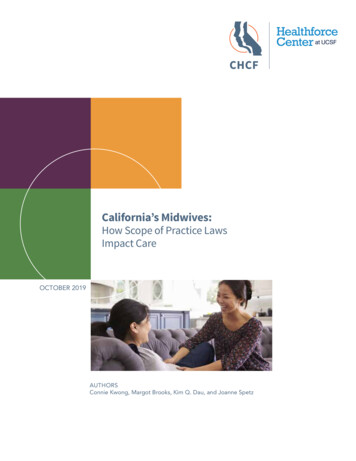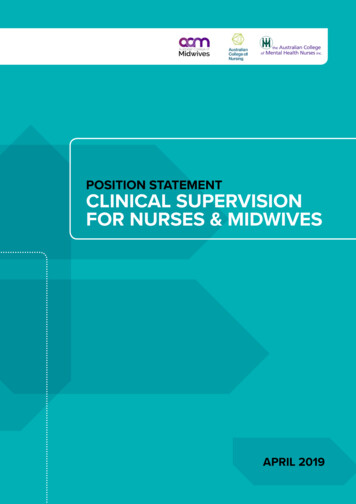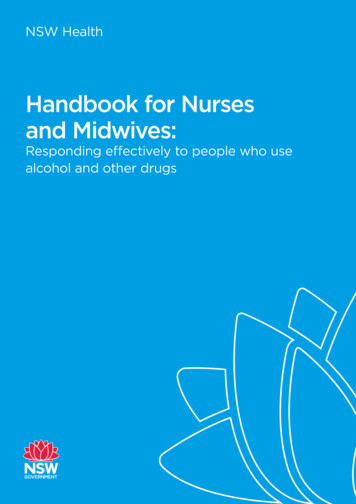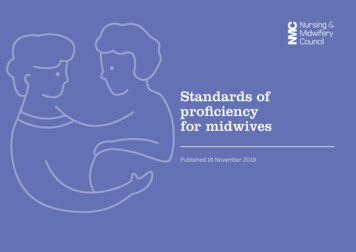
Transcription
Standards ofproficiencyfor midwivesPublished 18 November 2019www.nmc.org.ukStandards of proficiency for midwives1
ContentsIntroduction3Midwifery globally3The Future Midwife: the roleand scope of the midwife inthe 21st century4About these standardsof proficiency6The evidence6The Framework for QualityMaternal and NewbornHealth from The LancetSeries on Midwifery7How to read thesestandards of proficiency8The Domains9Key themes10Legislative framework12Domain 1: Being anaccountable, autonomous,professional midwifeDomain 2: Safe andeffective midwifery care:promoting and providingcontinuity of careand carerDomain 3: Universal carefor all women andnewborn infants131618Domain 4: Additional carefor women and newborninfants with complications 23Domain 5: Promotingexcellence: the midwifeas colleague, scholarand leader26Domain 6: The midwifeas skilled on, sharinginformation and relationshipmanagement: shared skillsfor Domains 1, 2, 3, 4 and 533Being an accountable,autonomous, professionalmidwife: skills for Domain 135Safe and effective midwiferycare: promoting and providingcontinuity of care and carer:skills for Domain 236Assessment, screening, planning,care and support across thecontinuum: shared skills forDomains 3 and 437Evidence-based medicinesadministration and optimisation:shared skills for Domains 3 and 440Universal care for all womenand newborn infants: skillsfor Domain 341Additional care for womenand newborn infants withcomplications: skills for Domain 447Promoting excellence: themidwife as colleague, scholarand leader: skills for Domain 551www.nmc.org.ukGlossary53The role of the Nursingand Midwifery Council56Standards of proficiency for midwives2
IntroductionThe Nursing and Midwifery Council has a duty toreview the standards of proficiency it sets for theprofessions it registers on a regular basis to ensurethat standards remain contemporary and fit forpurpose. In reviewing these standards, new evidenceand the changes that are taking place in society,midwifery, maternity and neonatal care services havebeen considered, along with the implications these havefor the role of midwives of the future.The standards of proficiency in this document specify theknowledge, understanding and skills that midwives mustdemonstrate at the point of qualification, when caring for womenacross the maternity journey, newborn infants, partners andfamilies across all care settings. They reflect what the publiccan expect midwives to know and be able to do in order to deliversafe, effective, respectful, kind, compassionate, person-centredmidwifery care.Midwifery globallyMidwifery is a global profession. Childbearing women, newborninfants, and families share similar needs wherever they live andmidwives make a vital contribution to their survival, health and wellbeing across the world. The World Health Organisation has statedthat ‘strengthening midwifery education is a key step to improvingquality of care and reducing maternal and newborn mortalityand morbidity’.These standards of proficiency are in alignment with theInternational Confederation of Midwives’ definition of the midwife:‘A midwife is a person who has successfully completed a midwiferyeducation programme that is based on the ICM EssentialCompetencies for Midwifery Practice and the framework of theICM Global Standards for Midwifery Education and is recognisedin the country where it is located; who has acquired the requisitequalifications to be registered and/or legally licensed to practicemidwifery and use the title ‘midwife’; and who demonstratescompetency in the practice of midwifery’.They also provide a benchmark for midwives from the EuropeanEconomic Area (EEA), European Union (EU) and overseas wishingto join the UK register, as well as for those who plan to return topractice after a period of absence.www.nmc.org.ukStandards of proficiency for midwives3
The Future Midwife: the role and scope of the midwife inthe 21st centuryThe role of the midwife is to provide skilled, knowledgeable,respectful, and compassionate care for all women, newborn infantsand their families. Midwives work across the continuum frompre-pregnancy, pregnancy, labour and birth, postpartum, and theearly weeks of newborn infants’ life. This includes women’s futurereproductive health, well-being, and decisions and in promotingvery early child development and the parents’ transition toparenthood. Midwives respect and enable the human rights ofwomen and children, and their priority is to ensure that care alwaysfocuses on the needs, views, preferences, and decisions of thewoman and the needs of the newborn infant.Midwives are fully accountable as the lead professional for thecare and support of women and newborn infants, and partners andfamilies. They provide care based on the best available evidence, andkeep up to date with current knowledge and skills, thereby helpingto ensure that their care is responsive to emerging evidenceand future developments. They work in partnership with women,enabling their views, preferences, and decisions, and helping tostrengthen their capabilities.Midwives optimise normal physiological processes, and supportsafe physical, psychological, social, cultural and spiritual situations,working to promote positive outcomes and to anticipate andprevent complications.Midwives make a vital contribution to the quality and safety ofmaternity care. They combine clinical knowledge, understanding,and skills with interpersonal and cultural competence. They makean important contribution to population health and understandsocial and health inequalities, and how to work to mitigate themthrough good midwifery care. They provide health education, healthpromotion and health protection to promote psychological andphysical health and well-being and prevent complications. Evidenceshows the positive contribution midwives make to the short- andlong-term health and well-being of women, newborn infants, andfamilies. Midwives provide and evaluate care in partnership withwomen, and their partners and families if appropriate, referring toand collaborating with other health and social care professionalsas needed.Midwives are ideally placed to anticipate and to recognise anychanges that may lead to complications and additional careneeds; these may be physical, psychological, social, cultural, orspiritual, and include perinatal loss and end of life care. When suchsituations arise, the midwife is responsible for recognising theseand for immediate response, management and escalation, involving,collaborating with and referring to interdisciplinary and multiagencycolleagues. In such circumstances, the midwife has specificresponsibility for continuity and coordination of care, providingongoing midwifery care as part of the multidisciplinary team, andacting as an advocate to ensure that care always focuses on theneeds, views, preferences, and decisions of the woman and theneeds of the newborn infant.www.nmc.org.ukStandards of proficiency for midwives4
Midwives provide safe, respectful, empowering, and equitablecare irrespective of social context and setting and includingwider reproductive health services. In all settings, the midwife isresponsible for creating an environment that is safe, respectful,kind, nurturing, and empowering.Critical thinking, problem solving, positive role modelling, andleadership development are fundamental components of safe andeffective midwifery practice. Midwives play a leading role in enablingeffective management and team working, promoting continuousimprovement, and encouraging a learning culture. Midwivesrecognise their own strengths, as well as the strengths of others.They take responsibility for their own continuing professionaldevelopment and know how they can contribute to others’development and education, including students and colleagues.They have the ability to develop in their careers in directions thatcan include practice, education, research, management, leadership,and policy settings. They continue to develop and refine theirknowledge, skills, resourcefulness, flexibility and strength, self-care,critical and strategic thinking, emotional intelligence, and leadershipskills throughout their career.www.nmc.org.ukStandards of proficiency for midwives5
About these standardsof proficiencyThe evidenceThese standards of proficiency have been developed throughan extensive and rigorous process of evidence review andconsultation, and consideration of the changing context inwhich midwives work. They reflect contemporary national andinternational evidence on the health, well-being, needs, views andpreferences of women and the needs of the newborn infant.The standards of proficiency have drawn on the evidence-informeddefinition of midwifery and the framework for quality maternal andnewborn care from The Lancet Series on Midwifery 2014 in helpingto shape the scope and content and ensure a consistent focuson the needs, views, preferences, and decisions of women and theneeds of newborn infants across the whole continuum of care.The definition of midwifery fromThe Lancet Series on MidwiferyMidwifery is defined as ‘skilled,knowledgeable, and compassionatecare for childbearing women, newborninfants, and families across thecontinuum throughout pre-pregnancy,pregnancy, birth, postpartum, and theearly weeks of life. Core characteristicsinclude optimising normal biological,psychological, social, and culturalprocesses of reproduction and earlylife; timely prevention and managementof complications; consultation with andreferral to other services; respect forwomen’s individual circumstances andviews; and working in partnership withwomen to strengthen women’s owncapabilities to care for themselvesand their families’1 .1. Renfrew, McFadden, Bastos, Campbell et al The Lancet 384, 1129-1145, 2014www.nmc.org.ukStandards of proficiency for midwives6
The Framework for Quality Maternal and Newborn Healthfrom The Lancet Series on MidwiferyFor all childbearing women and infantsPractice categoriesOrganisation of careValuesPhilosophyCare providersEducationInformationHealth promotionAssessmentScreeningCare planningPromotion of normalprocesses, preventionof complicationsFor childbearing women and infantswith complicationsFirst-linemanagementof complicationsMedical obstetricneonatal servicesAvailable, accessible, acceptable, good-quality services—adequate resources, competent workforceContinuity, services integrated across community and facilitiesRespect, communication, community knowledge, and understandingCare tailored to women’s circumstances and needsOptimising biological, psychological, social, and cultural processes; strengthening woman’s capabilitiesExpectant management, using interventions only when indicatedPractitioners who combine clinical knowledge and skills with interpersonal and cultural competenceDivision of roles and responsibilities based on need, competencies, and resourcesRenfrew, McFadden, Bastos, Campbell et al The Lancet 384, 1129-1145, 2014 (used with permission)www.nmc.org.ukStandards of proficiency for midwives7
How to read thesestandards of proficiencyThe standards of proficiency are stated asoutcomes that each midwife must achieveat the point of registration.The standards of proficiency are grouped under six Domains.These Domains inter-relate and build on each other, and shouldnot be seen separately. Together these reflect what we expect anew midwife to know, understand and be capable of doing safelyand proficiently, at the start of their career. This approach aimsto provide clarity to the public and the professions about theknowledge, understanding and skills they can expect every midwifeto demonstrate.www.nmc.org.ukStandards of proficiency for midwives8
The Domains:1. Being an accountable, autonomous, professional midwife6. The midwife as skilled practitioner2. Safe and effective midwifery care: promoting and providingcontinuity of care and carerCommunication, sharing information and relationshipmanagement skills: shared skills for Domains 1, 2, 3, 4 and 53. Universal care for all women and newborn infantsBeing an accountable, autonomous, professional midwife: skillsfor Domain 1A. The midwife’s role in public health, health promotion andhealth protectionB. The midwife’s role in assessment, screening and care planningC. The midwife’s role in optimising normal physiologicalprocesses and working to promote positive outcomesand prevent complications4. Additional care for women and newborn infantswith complicationsA. The midwife’s role in first line assessment and management ofcomplications and additional care needsB. The midwife’s role in caring for and supporting women andnewborn infants requiring medical, obstetric, neonatal, mentalhealth, social care, and other servicesSafe and effective midwifery care: promoting and providingcontinuity of care and carer: skills for Domain 2Assessment, screening, planning, care and support across thecontinuum: shared skills for Domains 3 and 4Evidence-based medicines administration and optimisation:shared skills for Domains 3 and 4Universal care for all women and newborn infants: skillsfor Domain 3Additional care for women and newborn infants withcomplications: skills for Domain 4Promoting excellence: the midwife as colleague, scholar andleader: skills for Domain 55. Promoting excellence: the midwife as colleague, scholarand leaderA. Working with others: the midwife as colleagueB. Developing knowledge, positive role modelling and leadership:the midwife as scholar and leaderwww.nmc.org.ukStandards of proficiency for midwives9
Key themesSeveral key themes run throughout the Domains, and include: evidence-based care and the importance of staying up-to-datewith current knowledge the physical, psychological, social, cultural, and spiritual safety ofwomen and newborn infants communication and relationship building, working in partnershipwith women enabling and advocating for the human rights of womenand children public health, health promotion, and health protection understanding and working to mitigate health andsocial inequalities interdisciplinary and multiagency working protecting, promoting and supporting breastfeeding the impact of pregnancy, labour and birth, postpartum, infantfeeding, and the early weeks of life on longer-term health andwell-being taking personal responsibility for ongoing learningand development enabling and advocating for the views, preferences, and decisionsof women, partners and families working across the whole continuum of care and in all settings,and understanding the woman’s and newborn infant’s wholematernity journey providing continuity of care and carer optimising the normal processes of reproduction and early life ensuring that women, partners and families have all theinformation needed to fully inform their decisions the importance of physical, psychological, social, cultural, andspiritual factors anticipating, preventing, and responding to complications andadditional care needswww.nmc.org.ukStandards of proficiency for midwives10
These standards of proficiency apply to all NMC midwives. Theyshould be read with Realising professionalism: Standards foreducation and training, which set out our expectations regardingprovision of all pre-registration and post-registration NMCapproved midwifery education programmes. These standards applyto all approved education providers and are set out in three parts:Part 1: Standards framework for nursing and midwifery educationPart 2: Standards for student supervision and assessmentPart 3: Programme standards, which are the standards specific foreach pre-registration or post-registration programme.Standardsframeworkfor nursingand midwiferyeducationEducation institutions must comply with our standards to beapproved to run any NMC approved programmes. Together thesestandards aim to provide approved education institutions (AEIs)and their practice learning partners with the flexibility to developinnovative approaches to education for midwives, while beingaccountable for the local provision and management of approvedpre-registration midwifery programmes in line with our standards.This is shown in the diagram below.Standardsfor studentsupervisionand assessmentProgrammestandardsStandardsof proficiencyfor nursingand midwiferyprofessionsPrePostStandardsfor educationand trainingThese standards of proficiency meet the ICM EssentialCompetencies for Midwifery Practice set by the InternationalConfederation of Midwives. They have been informed by theUnicef UK Baby Friendly Initiative University Standards.www.nmc.org.ukStandards of proficiency for midwives11
Legislative frameworkArticle 15(1) of the Order requires the Council to establishstandards for education and training which are necessary toachieve the standards of proficiency for admission to the register.The standards for nursing and midwifery education providers areestablished under the provision of Article 15(1) of the Order.Article 5(2) of the Nursing and Midwifery Order 2001 (‘the Order’)requires the NMC to establish standards of proficiency necessaryto be admitted to each part of the register and for safe andeffective practice under that part of the register. The standardsof proficiency have been established under this provision.www.nmc.org.ukStandards of proficiency for midwives12
Domain 1Domain 2Domain 3Domain 4Domain 5Domain 6GlossaryRole of theNursing and MidwiferyCouncilDomain 1: Beingan accountable,autonomous,professional midwifeMidwives are fully accountable as the lead professionalfor the care and support of childbearing women andnewborn infants, and partners and families. Respectinghuman rights, they work in partnership with women,enabling their views, preferences, and decisions, andhelping to strengthen their capabilities. They promotesafe and effective care, drawing on the best availableevidence at all times. They communicate effectively andwith kindness and compassion.www.nmc.org.ukStandards of proficiency for midwives13
Domain 1Domain 2Domain 3Domain 4Domain 5Domain 6GlossaryRole of theNursing and MidwiferyCouncil1. Outcomes:At the point of registration, the midwife will be able to:1.1 understand and act in accordance with The Code: Professionalstandards of practice and behaviour for nurses, midwives andnursing associates, and fulfil all registration requirements1.2 understand and act in accordance with relevant legal,regulatory, and governance requirements, policies, andethical frameworks including any mandatory reporting duties,differentiating where appropriate between the devolvedlegislatures of the United Kingdom1.3 understand and act to promote and enable the human rightsof women and newborn infants at all times, including women’s sexualand reproductive rights1.4 demonstrate the knowledge, skills, and ability to identify,critically analyse, and interpret research evidence and local,national, and international data and reports1.5 use, share and apply research findings and lessons from dataand reports to promote and inform best midwifery policy andpractice, and to support women’s evidence-informeddecision-making1.6 be accountable and autonomous as the lead professional forthe midwifery care and support of women and newborn infantsthroughout the whole continuum of care1.7 demonstrate knowledge and understanding of the role andscope of the midwife in the 21st Century1.8 demonstrate an understanding of and the ability to challengediscriminatory behaviour1.9 provide and promote non-discriminatory, respectful,compassionate, and kind care, and take account of any need foradjustments1.10 demonstrate understanding of women’s relationships andindividual family circumstances, and the ability to communicate andinvolve her partner and family in discussions and decisions abouther care and the care of the newborn infant, always respecting thewoman’s preferences and decisions about who to involve and theextent of involvement and communication1.11 use effective, authentic, and meaningful communication skillsand strategies with women, newborn infants, partners and families,and with colleagues1.12 develop and maintain trusting, respectful, kind, andcompassionate person-centred relationships with women, theirpartners and families, and with colleagues1.13 demonstrate the ability to always work in partnership withwomen, basing care on individual women’s needs, views, preferences,and decisions, and working to strengthen women’s own capabilitiesto care for themselves and their newborn infantwww.nmc.org.ukStandards of proficiency for midwives14
Domain 1Domain 2Domain 3Domain 41.14 act in the best interests of women and newborn infants atall times1.15 demonstrate the skills of advocacy and leadership,collaborating with and challenging colleagues as necessary, andknowing when and how to escalate concerns1.16 demonstrate the ability to advocate for women and newborninfants who are made vulnerable by their physical, psychological,social, cultural, or spiritual circumstances1.17 demonstrate knowledge and understanding of the range offactors affecting women, newborn infants, partners, and familiesand the impact these factors may have, including but not limited to:1.17.1 health and social inequalities and their determinants1.17.2 historical and social developments and trends1.17.3 cultural and media influences on public andprofessional understanding1.18 explain the rationale that influences their own judgements anddecisions, recognising and addressing any personal and externalfactors that may unduly influence their own decision-making inroutine, complex, and challenging situations1.19 understand and apply the principles of courage, integrity,transparency, and the professional duty of candour, recognisingand reporting any situations, behaviours, or errors that couldresult in sub-standard care, dysfunctional attitudes and behaviour,ineffective team working, or adverse outcomesDomain 5Domain 6GlossaryRole of theNursing and MidwiferyCouncil1.20 understand the importance of, and demonstrate the abilityto seek, informed consent from women, both for herself and hernewborn infant1.21 understand and respect the woman’s right to decline consent,and demonstrate the ability to provide appropriate care andsupport in these circumstances1.22 be able to advocate for the woman when her decision isoutside of clinical guidance, in order to minimise risk andmaintain relationships1.23 demonstrate the skills of numeracy, literacy, digital, media,and technological literacy needed to ensure safe and effectivemidwifery practice1.24 understand the importance of effective record keeping, andmaintain consistent, complete, clear, accurate, secure, and timelyrecords to ensure an account of all care given is available for reviewby the woman and by all professionals involved in care1.25 act as an ambassador, uphold public trust and promoteconfidence in midwifery and health and care services1.26 understand the professional responsibility to maintain thelevel of personal health, fitness, and well-being required to meet theneeds of women, newborn infants and families for psychological andphysical care1.27 take responsibility for continuous self-reflection, seekingand responding to all support and feedback to develop theirprofessional knowledge, understanding, and skills.www.nmc.org.ukStandards of proficiency for midwives15
Domain 1Domain 2Domain 3Domain 4Domain 5Domain 6GlossaryRole of theNursing and MidwiferyCouncilDomain 2: Safe andeffective midwiferycare: promoting andproviding continuityof care and carerMidwives promote continuity of care, and work acrossthe continuum from pre-pregnancy, pregnancy,labour and birth, postpartum, and the early weeks ofnewborn infants’ life. They work in the woman’s home,hospitals, the community, midwifery led units and allother environments where women require care bymidwives. The midwife is responsible for creating anenvironment that is safe, respectful, kind, nurturing,and empowering, ensuring that the woman’s experienceof care during her whole maternity journey is seamless.www.nmc.org.ukStandards of proficiency for midwives16
Domain 1Domain 2Domain 3Domain 4Domain 5Domain 6GlossaryRole of theNursing and MidwiferyCouncil2. Outcomes:At the point of registration, the midwife will be able to:2.1 demonstrate knowledge and understanding of the healthand social care system and of different settings for midwiferyand maternity care, and the impact of these on women, newborninfants, partners and families2.2 demonstrate knowledge and understanding of different waysof organising midwifery and maternity care, and the potentialpositive and negative impact of these on safety and effectiveness,and on women, their newborn infants, partners and families2.3 demonstrate knowledge and understanding of the range offactors affecting the provision of safe and effective midwifery andmaternity services and their impact on quality of care2.4 demonstrate the ability to work in and across a range ofhealth and social care settings and with other health and socialcare staff to promote continuity of care and carer2.5 demonstrate the ability to provide continuity of midwiferycarer across the whole continuum of care and in diverse settingsfor women and newborn infants with and without complications andadditional care needs2.6 demonstrate the ability to ensure that the needs of womenand newborn infants are considered together as a priority in allsettings, even when women and infants have to be caredfor separately2.7 demonstrate and apply knowledge and understanding of thesocial context in which women and their families live to inform,support, and assist in meeting their needs and preferences2.8 demonstrate knowledge and understanding of ways ofidentifying and reaching out to women who may find it difficult toaccess services, and of adapting care provision to meet their needs2.9 understand the need to work with other professionals,agencies, and communities to share knowledge of the needs ofwomen, newborn infants, partners and families when consideringthe impact of the social determinants of health on public health andwell-being2.10 work with other professionals, agencies, and communities topromote, support and protect breastfeeding, including protectionfor women to breastfeed in all settings2.11 demonstrate the ability to be the coordinator of care withinthe wider interdisciplinary and multiagency teams, arranging aseamless transfer of care when midwifery care is complete2.12 demonstrate an understanding of the need for an ongoingfocus on the promotion of public health and well-being of womenand newborn infants, their partners and families across all settings.www.nmc.org.ukStandards of proficiency for midwives17
Domain 1Domain 2Domain 3Domain 4Domain 5Domain 6GlossaryRole of theNursing and MidwiferyCouncilDomain 3: Universalcare for all womenand newborn infantsMidwives work in partnership with women to care forand support all childbearing women, newborn infants,and their families. They make an important contributionto population health, promoting psychological andphysical health and well-being. Midwives optimisenormal physiological processes, and support safepsychological, social, cultural and spiritual situations,working to promote positive outcomes and toanticipate and prevent complications.www.nmc.org.ukStandards of proficiency for midwives18
Domain 1Domain 2Domain 3Domain 4Domain 5Domain 6GlossaryRole of theNursing and MidwiferyCouncilA. The midwife’s role in public health, health promotion and health protection3.A Outcomes:At the point of registration, the midwife will be able to:3.1 demonstrate knowledge and understanding of the woman’slived experiences in everyday life, enabling access to public health,social care and community resources as needed3.6 understand the importance of human milk and breastfeedingto public health and well-being, and demonstrate how to protect,promote and enable breastfeeding with the woman, her partnerand family3.2 understand epidemiological principles and critically appraiseand interpret current evidence and data on public healthstrategies, health promotion, health protection, and safeguarding,and use this evidence to inform conversations with women,their partners, and families, as appropriate to their needs andpreferences3.7 demonstrate the ability to offer information and accessto resources and services for women and families in regard toviolence, abuse, and safeguarding3.3 demonstrate the ability to share information on public health,health promotion and health protection with women, enabling themto make evidence-informed decisions, and providing support foraccess to resources and services3.9 promote and support parent and newborn mental health andwell-being, positive attachment and the transition to parenthood3.4 demonstrate the ability to offer information and access toresources and services for women and families in regard to sexualand reproductive health and contraception3.8 understand and demonstrate how to support and provideparent education and preparation for parenthood, both forindividuals and groups3.10 demonstrate effective health protection throughunderstanding and applying the principles of infection preventionand control, communicable disease surveillance, and antimicrobialresistance and stewardship.3.5 understand the importance of birth to public health and wellbeing across the life coursewww.nmc.org.ukStandards of proficiency for midwives19
Domain 1Domain 2Domain 3Domain 4Domain 5Domain 6GlossaryRole of theNursing and MidwiferyCouncilB. The midwife’s role in assessment, screening and care planning3.B Outcomes:At the point of registration, the midwife will be able to:3.11 demonstrate knowledge and understanding of anatomy,physiology, genetics, and genomics of adolescent girls and womenand the reproductive system for adolescent boys and men3.12 demonstrate knowledge and understanding of normal ch
www.nmc.org.uk Standards of proficiency for midwives 5 Midwives provide safe, respectful, empowering, and equitable care irrespective of social context and setting and including

